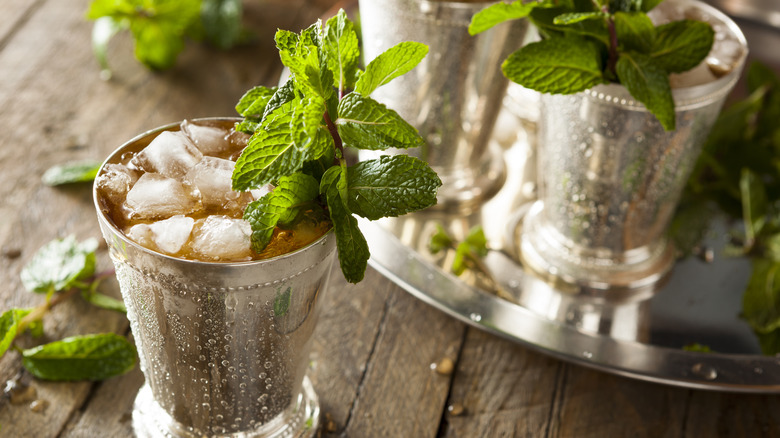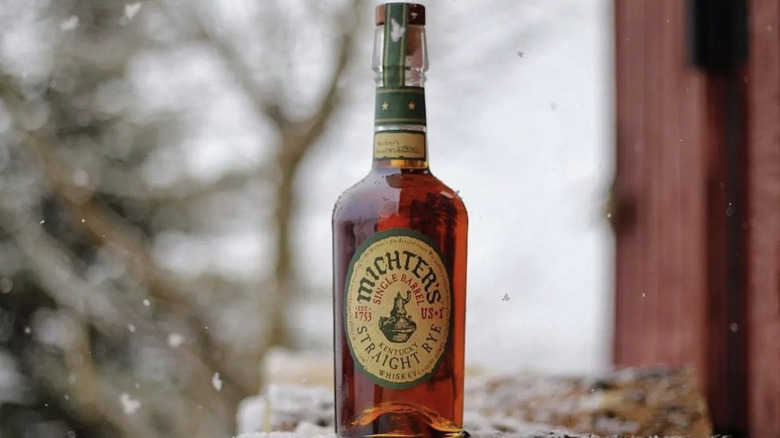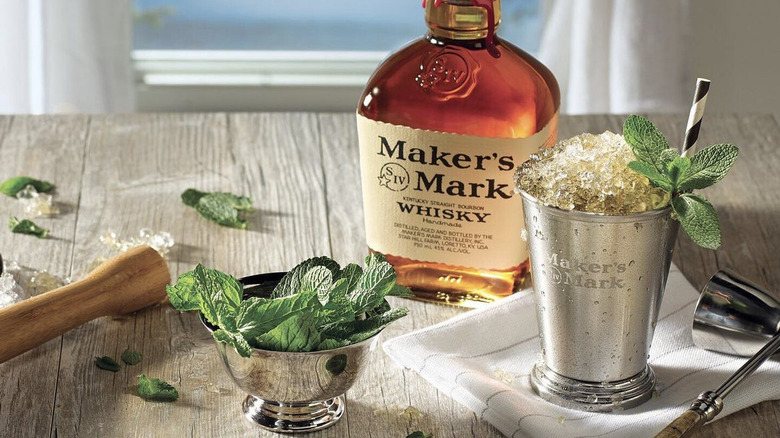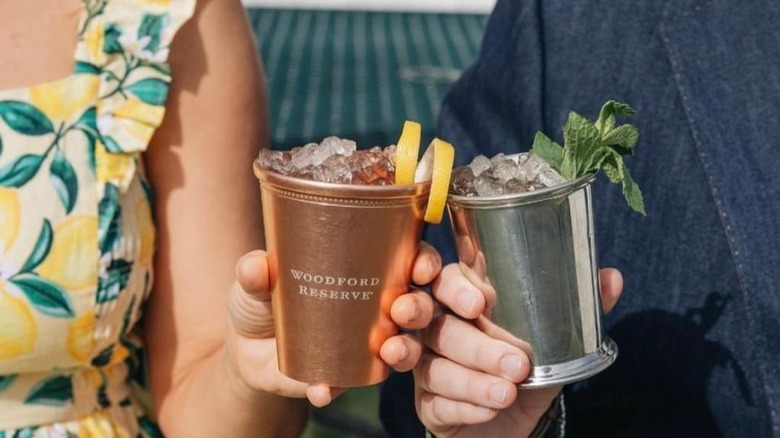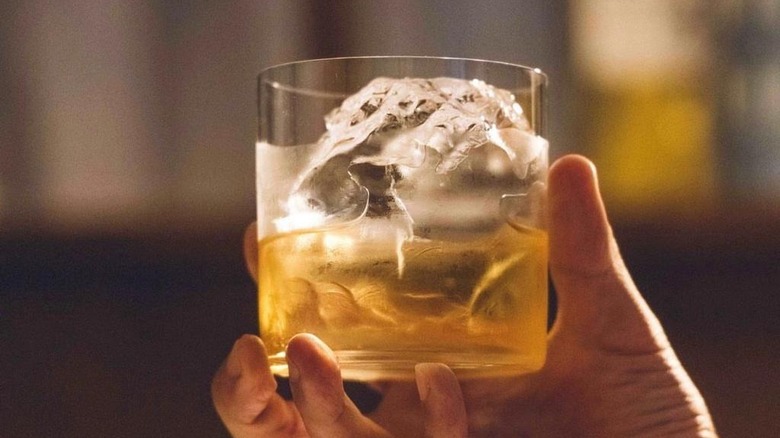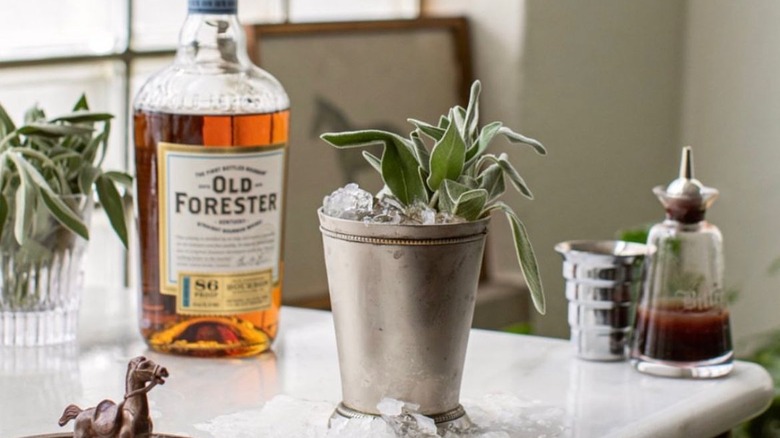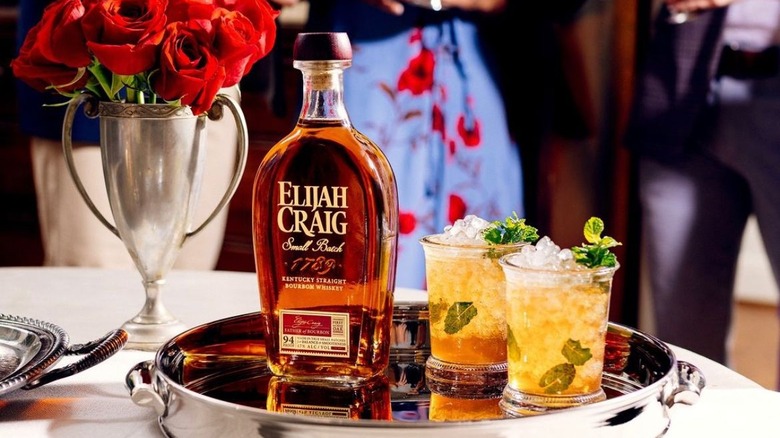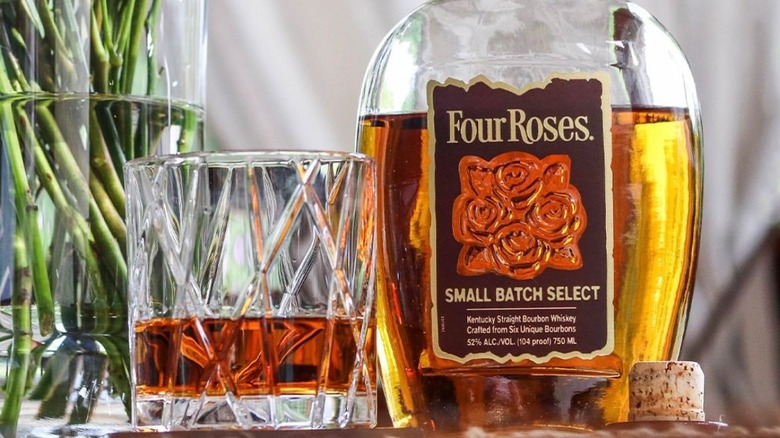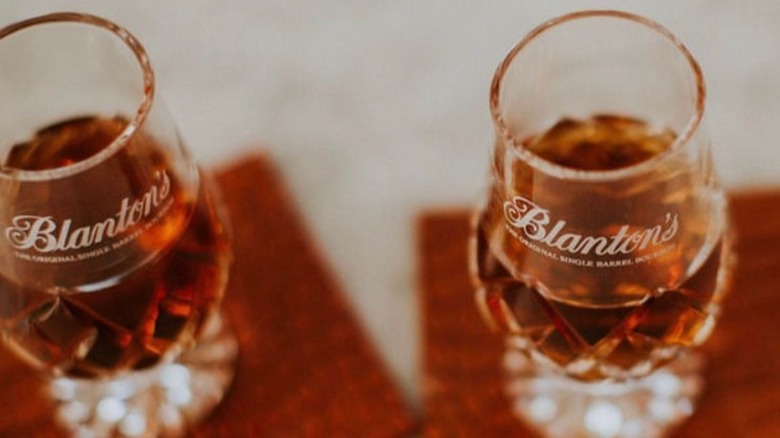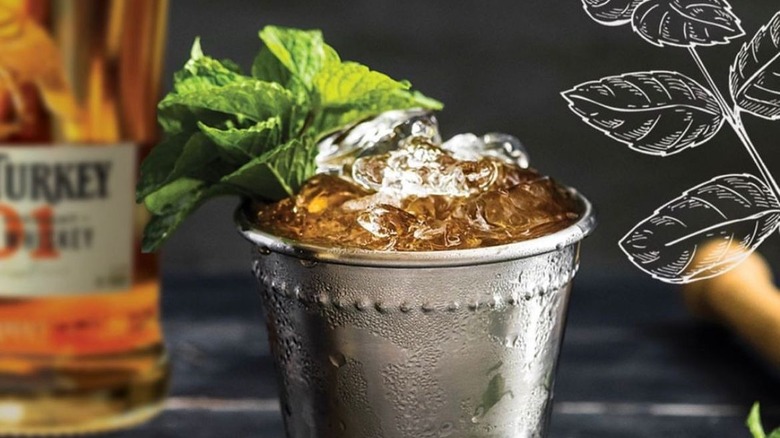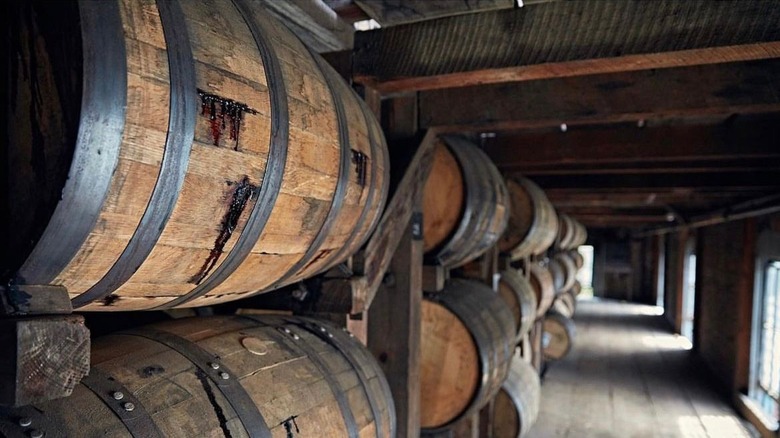10 Best Whiskeys For A Mint Julep
Refreshing, sweet, and very fun to drink, the mint julep is a classic bourbon cocktail traditionally associated with the glamour of the Kentucky Derby. On each Derby weekend, more than 120,000 juleps are served to thirsty guests at the Churchill Downs Racetrack.
The classic recipe calls for bourbon, sugar, fresh mint, and water. But as big of a Southern icon as it is, the origins of this classic concoction can be traced back to the Middle East. The first mentions of a julep (the word translates as rosewater) can be found in records of European medicine. This healing combination of sugar, herbs, spices, and sometimes a spirit eventually found its way to the United States. In the 19th century, horse track workers made the most of its medicinal properties and drank mint juleps in the morning, which helped them deal with their physical pain.
In our search for the perfect julep, we enlisted Rodrigo Urraca, co-founder of Mexico City's Handshake Speakeasy, which was just named the #2 Bar in North America at the 50 Best Bars in North America. Alongside Gustavo Almaraz, Handshake's whiskey expert, Rodrigo helped us pick the best 10 whiskeys for a mint julep.
Michter's Straight Rye
As one of the oldest whiskies in the United States, Michter's Straight Rye has a very unique and detailed production process. Made from sheared American rye grain, this whiskey is aged in new American white oak barrels that are toasted before they are charred. These steps help bring out the sugars in the wood, adding more color and flavor to the liquid. During the aging process, the barrels go through another process called heat cycling, which means that the temperature is increased and reduced for the whiskey to absorb more of the wood's properties. Although heat cycling is pretty expensive because it results in higher evaporation (also known as Angel's share), it yields a more flavorful spirit. Finally, the whiskey is chill-filtered. The resulting single-barrel whiskey has 42.4% alcohol volume (84.8 proof) and tasting notes of spice, pepper, oak, and butterscotch, making your mint julep sweet yet spicy. Another perk? Michter's is produced in Louisville, so your julep will be as Kentucky as it gets.
Maker's Mark
"A timeless classic that stands out as one of the best and most popular bourbons," says Rodrigo, Maker's is made in Loretto, Kentucky. Following the same process as they did back in 1953 when founder Bill Samuels Sr. set to create the brand began, the team at Maker's uses red winter wheat, which provides the whiskey with a delicate flavor. The second key ingredient is water from the distillery's surrounding areas, filtered through limestone; the third is an heirloom yeast strain that ferments in centuries-old tanks.
The bourbon rests in charred new American white oak barrels, which have been previously seasoned outdoors for nine months, removing tannins that affect the bourbon's flavor. Each barrel is rotated by hand, a tradition that dates back to Bill's days, and holds the liquid for six or seven years until it's ready.
Maker's unmistakable bottle, with its classic label and wax topper, was the work of co-founder Margie Samuels, who wanted to create a design that stood out on shelves. She used to hand-dip the bottles in wax in her kitchen, and today, each bottle is still hand-dipped at the distillery. Inside waits a bourbon with notes of sweet oat, vanilla, fruit, and wheat and a creamy finish with touches of spice. This will result in a classic Julep, sweet and smooth.
Woodford Reserve
For a luxuriously sweet and complex julep, look no further than this fine Kentucky bourbon. "This spirit has more than 200 detectable notes," explains Rodrigo, "including wood, spices, vanilla, fruits, and flowers." Part of Woodford's deep flavor comes from its unique grain recipe, featuring 72% corn, 18% rye, and 10% malted barley. Next comes the iron-free water, which comes from the distillery and is rich in minerals. A long fermentation process, plus a distillation process that takes place in pot stills and column stills, also helps to develop a flavorful liquid. Finally, the bourbon goes into toasted and charred barrels of new white American oak produced by the Woodford team, led by distillers Chris Morris and Elizabeth McCall. The result is a bourbon with tasting notes of dried fruit, mint, oranges, and touches of cocoa and vanilla on the nose, and citrus, cinnamon, and cocoa, plus plenty of spice, caramel, coffee, and chocolate on the mouth.
Named a National Historic Landmark, the Woodford Reserve Distillery is deeply tied to Kentucky and its bourbon-making tradition. Guests can visit the Versailles distillery for a full tour and a bourbon tasting.
Toki
The incomparable care and attention to detail that the Japanese are known are loved for is essential to Toki, a blended whisky from the House of Suntory (yes, as in "it's Suntory time"). For the past century, Suntory has been producing premium Japanese whisky ever since the opening of its first distillery near Kyoto. Here, at the Yamazaki Distillery — the first of five — founder Shinjiro Torii took inspiration from Scottish whisky, yet chose a place that is quite different to Scotland, aiming to create a liquid that was quintessentially Japanese.
"Toki," which means "time," blends the house's heritage and tradition with more innovative energy. You can find notes of basil, green apple, and honey on the nose, as well as green grapes, peppermint, thyme, and grapefruit on the palate. The subtle finish has hints of ginger, white pepper, and vanilla oak.
"This Japanese blended whisky is very versatile for cocktails," says Rodrigo, which means it will be a great ally as you prepare your julep. In fact, the brand has its own recipe, the Toki Julep, a fresh, herbal drink with a slice of grapefruit.
Old Forester 86 proof
"This bourbon has such an interesting story," points out Rodrigo. With a history that dates back to 1870 in Louisville, Old Forester was the first bottled bourbon in the market. In 1920, with the beginning of Prohibition, Old Forester was one of the very few distilleries that continued their production and the only one that still operates today. During World War II, Old Forester also made history. After the attack on Pearl Harbor, the distillery transformed its production to industrial-grade alcohol, supporting the country during the war. This rich history is concentrated at the distillery on Whiskey Row, where guests can visit and soak it all in with tours and tastings.
At 86 proof, as the name hints, Old Forester 86 proof is a bourbon with a rich, bold flavor. On the nose, it has floral notes mixed with aromas of tobacco leaf, mint, and vanilla, white oak, pine, sweet corn, and grain make an appearance on the palate, as do vanilla and orange. The bourbon's long, warm finish makes for a julep that has some strength at first, then softens nicely and boasts a sweet touch.
Elijah Craig Toasted Barrel
Baptist preacher Elijah Craig, a Georgetown, Kentucky visionary, not only brought the first paper and wool mills to town. He also had great talents as a distiller and was the first one to age whiskey in new charred oak barrels in 1789. While there are two versions to this story, one says an accidental fire burned the barrels, while another one says Craig used former sugar barrels to store the liquid and discovered the benefits of charring — the fact is that Craig was a pioneer with undeniable influence on the bourbon-making process.
To create Elijah Craig Toasted Barrel, it all begins with a mash bill of 78% corn, 10% aged rye, and 12% malted barley. Fresh Kentucky water, filtered by limestone, adds to the liquid's pureness. The small-batch bourbon is aged in charred oak barrels and finished in a second toasted barrel, resulting in a deeply interesting whiskey. At first, you'll feel the deep aromas of toasted oak and caramel, followed by notes of spice, pepper, and milk chocolate on the palate, followed by a touch of smoke. Notes of chocolate and spices linger during the complex, warm finish, meaning an Elijah Craig mint julep will be rich and deep-flavored.
Four Roses Bourbon
Fruity and floral notes on the nose, along with spice and honey, will be present during your first encounter with this bourbon. Next will come more fresh fruit, apple, and pear on the palate, leading up to a mellow finish. These traits make Four Roses bourbon perfect for a fresh, crisp mint julep. But there is much to discover behind these flavors, a blend that Rodrigo describes as "very smooth and balanced."
At Four Roses, the team works with a combination of two mash bills made with corn, rye, and malted barley, as well as five yeast strains. This means they have 10 different recipes, each with different levels of fruit and spice, which are used in various combinations to create their bourbons. Four Roses Bourbon features all 10 recipes, as well as limestone-filtered water from the Salt River. After fermentation and double distillation, the bourbon is aged for at least five years in charred new American oak barrels, emerging as an 80-proof, smooth bourbon.
Blanton's Original
The story of this Kentucky bourbon takes us back to 1984, when Master Distiller Elmer T. Lee, a Kentucky Bourbon Hall of Famer, was about to retire. But before that happened, he was assigned an important task: to create an incredible bourbon. For inspiration, he looked back to his early distilling days when he worked alongside distillery president Colonel Albert B. Blanton, who liked to choose honey barrels from the brand's iconic Warehouse H for special occasions and bottle the liquid one barrel at a time. "They were the first to produce single-barrel bourbon, which was very revolutionary in its time," says Rodrigo.
Blanton's Original Single Barrel boasts notes of vanilla, caramel, and baking spices on the nose, as well as oak and citrus on the palate. One of the reasons that Blanton's has such a rich flavor is the fact that the walls of Warehouse H are made of metal, so they allow for the temperature inside to be quite similar to the one outside. This means that the bourbon will be more sensitive to weather-related temperature changes as it is absorbed and released from the barrels over and over. The 93-proof bourbon will bring intensity to your julep. To make it more festive, you will notice that each bottle has a horse on the bottle stopper, a tribute to Kentucky's horsing traditions.
Wild Turkey 101
Wild Turkey Hill in Lawrenceburg, Kentucky, is home to this bourbon distillery with more than 75 years of history. Wild Turkey 101 starts with a blend of non-GMO corn, rye, and malted barley that is particularly interesting because of its high rye content. "The rye, and the fact that the mash has less water, give it a very distinctive flavor," says Rodrigo. The grain blend is cooked in pure, limestone-filtered water from the Kentucky River. Next, comes the malted barley, followed by the company's secret yeast mash for fermentation. After, the liquid mash is distilled twice and stored in American white oak barrels that have been charred up to a level 4, also known as "alligator char." The bourbon rests here to age between six and eight years, following a process that hasn't changed in six decades.
The resulting 101-proof bourbon has aromas of vanilla, oak, and cinnamon and flavors of sweet vanilla, caramel, baking spices, and oak. With a bold finish featuring notes of spice and orange peel, it can be the star in a unique Julep with plenty of character.
Pappy van Winkle's Family Reserve 23 year
Referring to a fine bourbon on a first-name basis is no joke, but that's the level of love that Pappy van Winkle can inspire. It all started a century ago with the legendary Julian Pappy van Winkle, who started his influential career as a whiskey salesman at W.L. Weller & Sons. There, he later became president of the distillery. History tells us that he never planned to enter the whiskey business, but his commitment to making exquisite bourbon gave him a solid reputation in the industry. His son, Julian Jr., followed in his footsteps, founding J.P. Van Winkle and Son and creating the Old Rip Van Winkle label. Later came Julian III and his son Preston, who helped double the size of the sales team at the distillery.
Today, Pappy van Winkle Family Reserve 23 year is one of the distillery's most treasured liquids. Rodrigo calls it a "fine, elegant bourbon, with great attention to detail shown along every step of its production." After careful distillation, this liquid rests in specially selected barrels for three additional years. This bourbon offers flavors of caramel, cherries, apples, oak, tobacco, and chocolate, followed by a long finish with notes of wood and caramel. You'd be hard-pressed to find a more elegant julep than one made with this "jewel of a bourbon," as Rodrigo describes it.
